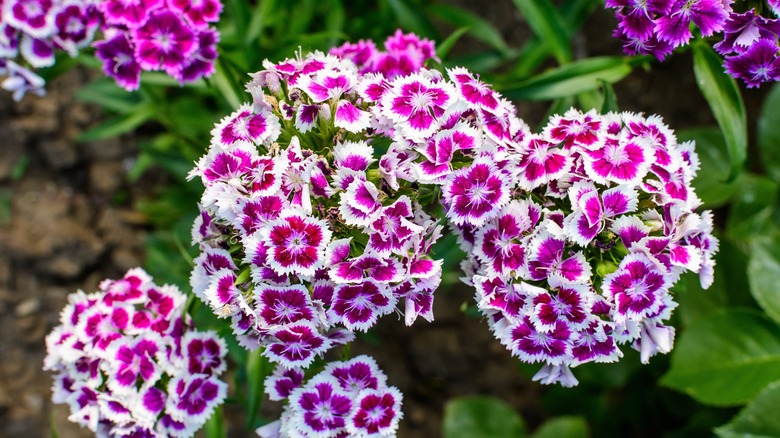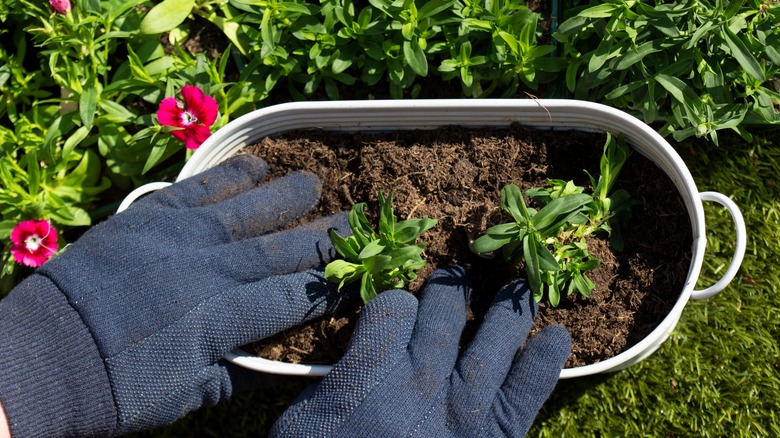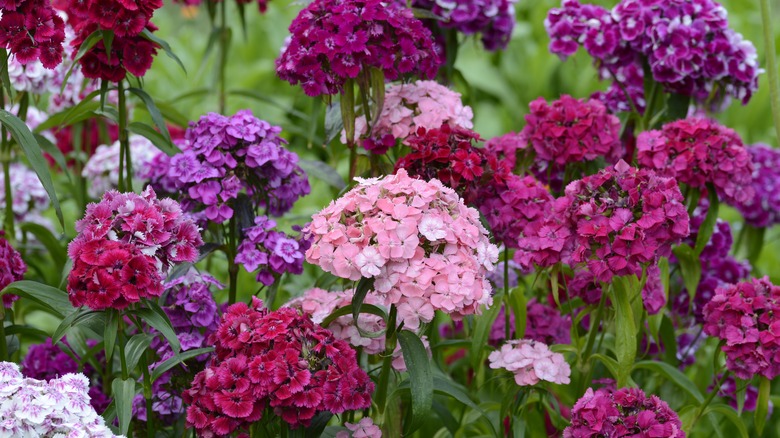The Best Growing Conditions To Ensure Your Sweet William Flowers Thrive
We may receive a commission on purchases made from links.
Most people are familiar with carnations (Dianthus caryophyllus). These flowers with ruffled petals are said to symbolize a mother's love, although they can represent love for anyone they're gifted to. Sweet William (Dianthus barbatus) — which shouldn't be confused with the shade-loving wild sweet William of the Phlox genus (Phlox divaricata) – is a relative of classic carnations. In fact, the flowers share many traits, including the same taxonomic category: Dianthus, meaning "flower of the gods" or "divine flower." Still, sweet Williams are certainly mortal and grown as annuals or self-seeding biennials in USDA zones 3 to 9. With the right conditions, the plants can function as short-lived perennials. They require deep, well-draining soil to sink their roots into and direct sunlight throughout the day with some shade from the afternoon sun to thrive.
The sweet William flower sometimes, but not always, lives up to its namesake, featuring clusters of multicolored blooms in warm shades of pink, red, or purple that appear throughout the spring and summer, often reblooming until the first frost. Each blossom emanates a fragrance likened to the sweet and spicy scent of clove by some; however, recently, gardeners have noted that newer cultivars have little to no smell. When planning for sweet William in your garden, choose their placement carefully, considering the soil and the amount of water and sunlight the location will likely receive. With proper care, you can expect to grow healthy Dianthus flowers with a more satisfying blooming period.
How to plant and care for sweet William flowers
In the perfect scenario, sweet William would be planted in the spring in organically rich soil that is kept consistently moist but not soaked. You'll need to water your flowers at least once per week and more often during particularly warm weather. Slightly alkaline soil is best for sweet William flowers, with a pH between 6.0 and 7.5. You can check your soil pH with the help of a soil pH meter for $10 on Amazon. However, if you prefer a cheaper method, test its alkalinity by adding about 1 cup of garden soil to a bowl with ½ cup of vinegar. Watch for fizzing bubbles. If they appear, your soil is alkaline with a pH of around 7, but if nothing happens, you may need to amend your soil with baking soda or garden lime.
After preparing your soil, double-check that the sunlight in this area is appropriate for your flowers. A spot that receives at least six hours of direct sun is ideal, but because sweet William has trouble withstanding high heat, some shade is necessary during the hottest parts of the day to keep them happy. Plant sweet William flowers directly into your garden beds or planters, spacing them 6 to 12 inches apart. Growing them in groups allows for a denser look with masses of foliage and clustered flowers lending themselves nicely to a cottage garden theme or a pollinator garden for attracting bees, moths, and butterflies.
Setting up sweet William flowers for success
The right conditions, including a temperate USDA zone, rich soil, and bright (not hot) sunlight, will provide sweet William flowers with everything they need to succeed throughout the growing season. But, as any gardener might expect, there are some things you should watch out for to ensure your flowers sustain their perky look for as long as possible and don't suffer an avoidable death. The main concern for Dianthus is soil moisture. Soggy, overwatered plants risk contracting stem rot, crown rot, and rust. This is easily preventable when you ensure they are planted in well-draining soil and stick to a regular watering schedule, but overwatering isn't the only contributing factor. Mulching with organic compost can also trap moisture, leading to rotting stems and roots.
Another way you can help your flowers might sound a little backward. You should deadhead sweet William flowers to encourage them to rebloom. As the end of summer draws near, inspect your plants for lackluster, spent flower heads and snip them off with clean pruning shears. You may do a big cut to ensure you get lots of new flowers, but consider leaving a few intact if the seeds from the plant are viable. This will allow the short-lived perennial/biennial to self-seed for the following seasons.


